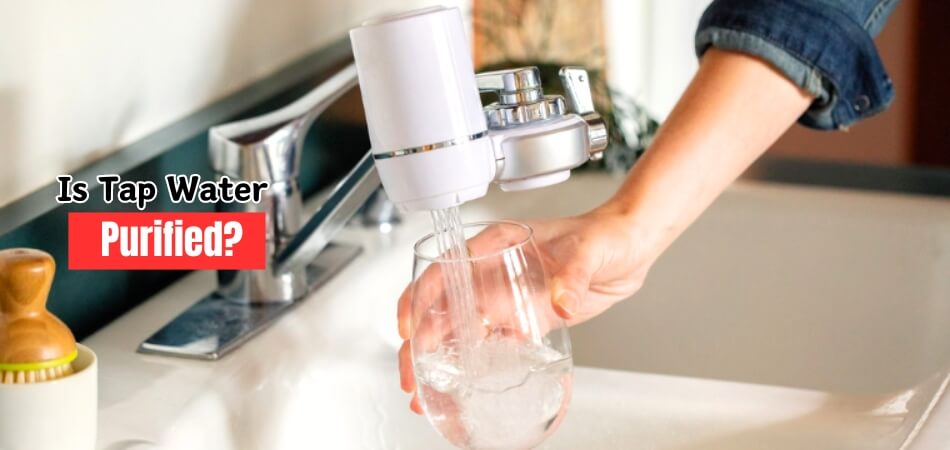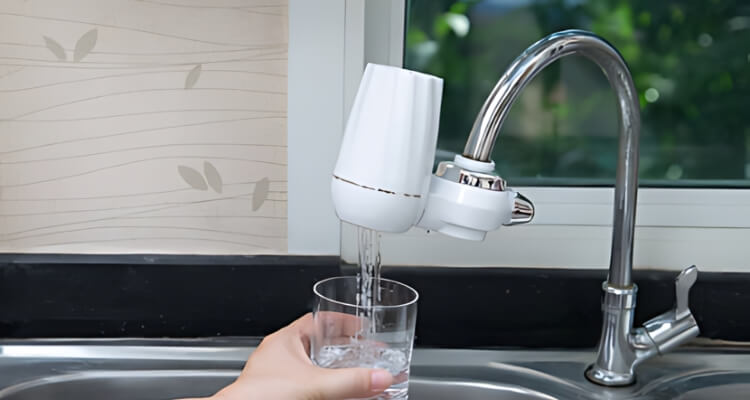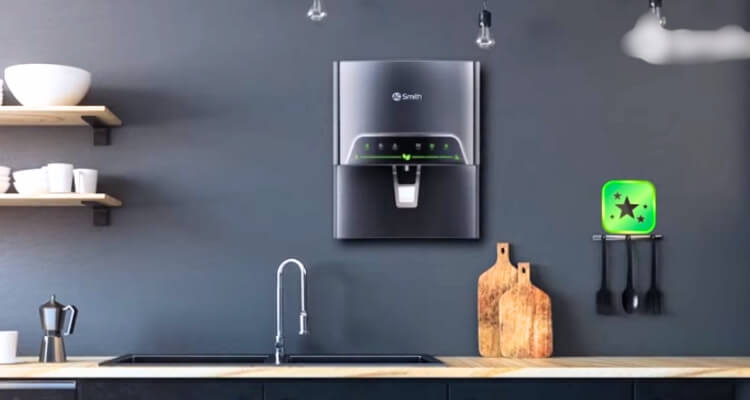Water purifiers are an essential tool in modern homes, serving as a guardian against impurities in our tap water. These devices, ranging from complex systems to simple portable solutions like the GOpure Pod, employ sophisticated filtration technologies to tackle contaminants that might be lurking in your water supply.
This leads us to the burning question: “Is Tap Water Purified?”
The short answer is, not always sufficient. Products like the GOpure Pod enhance the safety and cleanliness of tap water by removing harmful impurities, thus providing peace of mind and better health for your family.
Curious about how these systems can be integrated into your daily life and the specific impurities they combat? Stick with us as we fall deeper into the world of tap water purification and discover how to ensure your water is as clean and safe as possible.
What is Tap Water?
Tap water is the water that comes directly from your faucet at home. It’s sourced from local reservoirs, rivers, or groundwater, and then treated to make it safe for drinking.

Tap water can contain impurities like chlorine, lead, or microplastics, depending on the quality of the water treatment process in your area. That’s where products like the GOpure Pod come in handy.
The GOpure Pod is a water purification device that you can easily use at home to filter your tap water. It works by releasing natural minerals into the water to remove contaminants.
Using a GOpure Pod, you can enjoy cleaner and healthier drinking water without the need for plastic water bottles or expensive filtration systems. Plus, it’s an eco-friendly choice that reduces plastic waste.
With the GOpure Pod, you can have peace of mind knowing that you’re drinking water that’s free from harmful impurities, making hydration both convenient and environmentally conscious.
Is Tap Water Purified?
Are you ever curious as to how your tap water becomes so safe to drink? Here’s what you need to know about Is Tap Water Purified?

Tap Water Purification
When you turn on your faucet and fill up a glass of water, you’re likely relying on your local water treatment facility to ensure that water is safe for consumption. But how does that water get purified? Is tap water purified enough to drink without worry?
The Purification Process
First things first, when water is collected from its source, whether it’s a river, lake, or groundwater well, it’s not necessarily clean and ready to drink. That’s where water treatment plants come in. These facilities have a series of steps to purify the water and make it safe for us to use.
Removing Impurities
One of the initial steps in water purification is filtration. Large debris like sticks, leaves, and rocks are removed, followed by finer filtration to get rid of smaller particles like sand and silt. This helps clear the water and makes it safer for further treatment.
Killing Harmful Microorganisms
After filtration, the water often undergoes chemical treatment. This involves adding substances like chlorine or ozone to kill harmful bacteria, viruses, and other microorganisms that can cause illnesses if consumed.
Additional Treatment Methods
In some cases, additional treatment methods might be employed, depending on the source of the water and the specific contaminants present. This could include processes like activated carbon adsorption to remove organic compounds or advanced oxidation to break down pollutants.
Ensuring Safety
Throughout the purification process, water quality is continuously monitored. Samples are regularly taken and tested for various contaminants to ensure that the water meets safety standards set by regulatory agencies.
The Factors that Affect the Quality of Tap Water
Would you like to know why tap water tastes different according to where you live? The quality of the water flowing from your faucet is affected by a number of factors. I would like to take a closer look at this!
Source of Water
Where your tap water comes from matters. Whether it’s sourced from a river, lake, groundwater well, or reservoir, the quality of the water at its source can vary depending on factors like pollution levels and natural contaminants.
Treatment Processes
The methods used to purify tap water can influence its quality. Different treatment plants may employ various techniques, such as filtration, chemical disinfection, and advanced purification methods, which can impact the taste, odor, and safety of the water.
Age and Condition of Pipes
The pipes that deliver water to your home can also play a role in its quality. Older or corroded pipes may leach contaminants into the water, affecting its taste and potentially posing health risks. Similarly, infrastructure issues like leaks or breaks can introduce impurities into the water supply.
Seasonal Variations
The quality of tap water can fluctuate throughout the year, depending on seasonal factors. For example, heavy rainfall or snowmelt can increase the turbidity of surface water sources, requiring additional treatment to maintain water quality standards.
Geographical Location
Where you live can impact the quality of your tap water. Areas with industrial activity or agricultural runoff may have higher levels of contaminants in their water supply. Additionally, natural geological conditions, such as high mineral content or presence of heavy metals, can affect water quality.
Regulatory Compliance
Government regulations play a crucial role in ensuring the safety of tap water. Regulatory agencies set standards for acceptable levels of contaminants in drinking water and require water utilities to regularly monitor and report on water quality. Compliance with these regulations helps safeguard public health.
Consumer Habits
The way consumers use and store water can influence its quality. For example, leaving water sitting in a container for an extended period or using unclean utensils to handle water can introduce bacteria or other contaminants.
How Does Tap Water Purification Work?
Tap water purification is a multi-step process that ensures the water flowing from your faucet is safe for consumption. Here’s a step-by-step guide to how it works:

Step 1: Filtration
The first step in tap water purification involves passing the water through a filtration system. This removes large particles like sediment, dirt, and debris, leaving the water clearer and cleaner.
Step 2: Chemical Treatment
Next, the water undergoes chemical treatment to kill harmful bacteria and other microorganisms. Common chemicals used in this process include chlorine and ozone, which disinfect the water and make it safe to drink.
Step 3: Activated Carbon Adsorption
Some purification systems use activated carbon to adsorb organic compounds and remove unpleasant tastes and odors from the water. This helps improve the overall quality and taste of the tap water.
Step 4: Reverse Osmosis
In more advanced purification systems, reverse osmosis may be employed to remove contaminants on a molecular level. This process uses a semipermeable membrane to filter out impurities, producing exceptionally pure water.
Step 5: UV Disinfection
Another method used in tap water purification is UV disinfection. Ultraviolet light is used to destroy the DNA of bacteria, viruses, and other pathogens, effectively sterilizing the water without the need for chemicals.
Step 6: Final Filtration
Before reaching your faucet, the purified water may undergo one final filtration step to remove any remaining particles or impurities. This ensures that the water is as clean and safe as possible for consumption.
While tap water purification systems are highly effective, additional measures can be taken to enhance water quality. Products like the GOpure Pod provide an extra layer of purification by using natural minerals to remove contaminants and improve taste.
How Do You Get Purified Water from A Tap?
Ever wondered how that clear, refreshing water flows from your tap? Let’s unravel the mystery and explore the journey from source to faucet!
The Magic Behind Purified Tap Water
When you turn on your tap and fill up a glass with crystal-clear water, you’re witnessing the result of a remarkable purification process. Here’s how this transformation occurs.
Collecting Water From the Source
Tap water starts its journey from a natural source like a river, lake, or groundwater well. Initially, this water may contain impurities and contaminants picked up along the way.
Treatment at the Water Plant
Before reaching your tap, the water undergoes rigorous treatment at a water purification plant. Here, it’s subjected to various processes to remove harmful substances and make it safe for consumption.
Clearing Out Impurities
One of the first steps is filtration, where the water passes through layers of sand, gravel, and activated carbon. This helps remove particles, sediment, and organic matter, leaving the water clearer and cleaner.
Chemical Treatment
Next up is chemical treatment. Chlorine or other disinfectants are added to kill bacteria, viruses, and other microorganisms lurking in the water. This step ensures that the water is safe to drink.
Improving Taste and Quality
To further improve taste and quality, additional treatments may be applied. These could include adjusting the pH level or adding minerals to enhance flavor and provide health benefits. Purified water does not dehydrate the body. Purified water hydrates your body just as effectively as any other clean, safe water source.
Final Checks and Balances
Before the water makes its way to your tap, it undergoes rigorous testing to ensure it meets strict safety standards. Regular monitoring and quality control measures ensure that every drop that flows from your faucet is pure and clean.
The GOpure Pod Difference
For an extra layer of purification right at your tap, consider using a GOpure Pod. This innovative device uses natural minerals to filter out contaminants, leaving you with delicious, purified water straight from your tap.
What Is the Best Water Purifier for Your Home?
Certainly! When considering the best water purifier for your home, it’s essential to balance effectiveness, convenience, and cost. Here’s a concise guide to help you guide your choices:

Realize Your Needs
Before you fall into purchasing, assess the quality of your tap water. This determines the type of purifier you’ll need. For instance, if you’re dealing with hard water, a purifier that also softens water might be ideal.
Types of Purifiers
- Reverse Osmosis (RO): Excellent for removing a wide range of contaminants, including sediments and heavy metals.
- Activated Carbon: Good for improving taste by removing chlorine and other chemicals.
- UV Filters: Effective at killing bacteria and viruses without altering the water’s taste.
Convenience and Maintenance
Consider how much maintenance each type of purifier requires. RO systems, for instance, might need more frequent filter changes compared to UV filters.
Cost-Effectiveness
Analyze not just the upfront cost but also long-term expenses like replacement filters and energy usage.
Innovative Solutions
One interesting product to consider is the GOpure Pod. It’s a portable solution that you can simply drop into any bottle or container to purify the water. It’s particularly handy for ensuring safe drinking water on the go or at home, making it a versatile addition to your water purification strategy.
Space Considerations
Some systems, like under-sink RO purifiers, require significant space. If space is a concern, a compact option like the GOpure Pod can be very appealing.
Environmental Impact
If sustainability is a priority for you, look for systems that minimize waste, such as those that do not require electricity or produce minimal water waste.
FAQs for Is Tap Water Purified?
Tap water purification is a common concern for many. Insight the process and its implications is essential. Here are seven FAQs along with detailed answers regarding tap water purification:
How Effective Are These Purification Methods in Removing Contaminants?
Purification methods employed for tap water are generally effective in removing various contaminants, including bacteria, viruses, heavy metals, pesticides, and chlorine byproducts, ensuring water safety and quality.
Can Tap Water Still Contain Impurities After Purification?
Despite purification efforts, trace amounts of certain contaminants may remain in tap water. However, these levels are typically within safe limits established by regulatory agencies to ensure public health.
Are There Any Health Risks Associated with Drinking Tap Water?
When tap water meets regulatory standards, it is generally safe for consumption. However, certain contaminants, if present in high concentrations, can pose health risks, necessitating periodic testing and monitoring.
How Can I Ensure the Quality of Tap Water in My Home?
You can ensure tap water quality by using certified water filters, regularly maintaining plumbing systems, and periodically testing water quality through accredited laboratories to detect any potential contaminants.
Is Tap Water Purification Consistent Across Different Regions?
Tap water purification processes and standards may vary between regions depending on factors such as water sources, infrastructure, and regulatory requirements. However, all systems aim to provide safe drinking water to their respective populations.
Bottom Line
Our tap water needs to be safe and clean in today’s world. A variety of purification methods, including traditional filtration and innovative devices like the GOpure Pod, help address water quality concerns. As we hydrate throughout the day, these systems remove impurities and contaminants.
The purification process sheds light on the journey our tap water takes from source to faucet. Knowing the steps involved gives us a better understanding of how clean and safe water is delivered to our homes. We can use this information to make informed decisions about our water consumption, ensuring that every sip we take is refreshing and reliable.
Is tap water purified? Without a doubt. A rigorous filtration process, chemical treatment, and ongoing monitoring ensure that tap water meets stringent safety standards. Staying informed about water quality and embracing solutions like the GOpure Pod can help us enjoy the refreshing taste of purified tap water while prioritizing our health.






